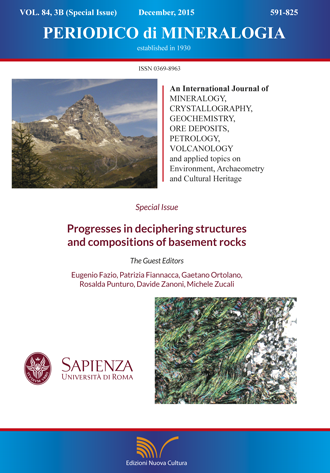U-Th-Pb “multi-phase” approach to the study of crystalline basement: application to the northernmost sector of the Ivrea-Verbano Zone (Alps)
DOI:
https://doi.org/10.2451/2015PM0435Keywords:
U–Pb geochronology, LA-ICP-MS, Kinzigite Formation, Valle Cannobina, Ivrea-Verbano ZoneAbstract
In situ U-Pb geochronology was carried out on amphibolites and siliciclastic metasediments of the Kinzigite Formation exposed in the northernmost sector of the Ivrea-Verbano Zone (Finero area). The aim is to shed light on the tectono-metamorphic evolution of this intermediate-lower crustal section and its bearing with the evolution of the southern and better known sectors of the IVZ. Based on field observation and petrography a metamorphic gradient gently increasing from amphibolite to upper amphibolite facies (from SE to NW) characterizes the whole metamorphic sequence. Metapelites consist mainly of biotite, quartz, plagioclase, garnet, and sillimanite; muscovite progressively disappears as K-feldspar appears and becomes abundant. Amphibolites are made of green-brown hornblende and plagioclase and may contain clinopyroxene defining thin layers together with plagioclase and titanite. Both metapelites and amphibolites show mylonitic deformation which is more intense towards NW, i.e. towards the lower structural levels. The mylonitic deformation strongly affected the lower crustal metabasic rocks of External Gabbro unit (Finero Mafic Complex). Zircon, monazite and titanite U-Pb geochronology was carried out with laser ablation (LA)-ICP-MS on amphibolites, migmatitic paragneiss and mafic granulites occurring as slivers of the Kinzigite Formation in the External Gabbro unit of the Finero Mafic Complex. The multi-chronological approach allowed recognizing three discrete tectono-metamorphic events, at Permian, Triassic and Jurassic. Zircon and monazite yielded Permian ages suggesting (re)crystallization during an high temperature event characterized by both metamorphism and magmatism. Titanite dating provided Triassic and Jurassic ages that were interpreted as U-Pb resetting ages. A Triassic perturbation of the U-Pb system was also recorded by zircon and monazite as rare domains. The tectono-metamorphic reconstruction of the evolution of the northernmost IVZ, as revealed by the new geochronological data, is only partially in agreement with the temperature-time evolutions depicted for the southern sectors of the IVZ. Permian ages indicating magmatism and high temperature metamorphism are common throughout the IVZ, as well as the Jurassic ages related to local thermal pulses and tectonic activity. Conversely, the occurrence of well-constrained Triassic ages is in fact peculiar of the Finero area. Two possible explanations may account for this Triassic event: Triassic ages are possibly related to the thermal effect and fluid circulation during the emplacement of the External Gabbro unit; or alternatively, they are the response to the ductile deformation largely recognized in the whole area. This study is a further evidence of the necessity of approaching crystalline basement with multiple geochronometers in order to unravel the complete tectono-metamorphic evolution.


